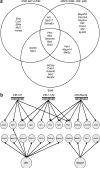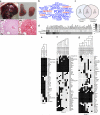A Sleeping Beauty forward genetic screen identifies new genes and pathways driving osteosarcoma development and metastasis
- PMID: 25961939
- PMCID: PMC4767150
- DOI: 10.1038/ng.3293
A Sleeping Beauty forward genetic screen identifies new genes and pathways driving osteosarcoma development and metastasis
Abstract
Osteosarcomas are sarcomas of the bone, derived from osteoblasts or their precursors, with a high propensity to metastasize. Osteosarcoma is associated with massive genomic instability, making it problematic to identify driver genes using human tumors or prototypical mouse models, many of which involve loss of Trp53 function. To identify the genes driving osteosarcoma development and metastasis, we performed a Sleeping Beauty (SB) transposon-based forward genetic screen in mice with and without somatic loss of Trp53. Common insertion site (CIS) analysis of 119 primary tumors and 134 metastatic nodules identified 232 sites associated with osteosarcoma development and 43 sites associated with metastasis, respectively. Analysis of CIS-associated genes identified numerous known and new osteosarcoma-associated genes enriched in the ErbB, PI3K-AKT-mTOR and MAPK signaling pathways. Lastly, we identified several oncogenes involved in axon guidance, including Sema4d and Sema6d, which we functionally validated as oncogenes in human osteosarcoma.
Figures








References
-
- Kansara M, Thomas DM. Molecular pathogenesis of osteosarcoma. DNA Cell Biol. 2007;26:1–18. - PubMed
-
- Tsuchiya H, et al. Effect of timing of pulmonary metastases identification on prognosis of patients with osteosarcoma: the Japanese Musculoskeletal Oncology Group study. J. Clin. Oncol. 2002;20:3470–3477. - PubMed
-
- Kager L, et al. Primary metastatic osteosarcoma: presentation and outcome of patients treated on neoadjuvant Cooperative Osteosarcoma Study Group protocols. J. Clin. Oncol. 2003;21:2011–2018. - PubMed
Publication types
MeSH terms
Substances
Grants and funding
LinkOut - more resources
Full Text Sources
Other Literature Sources
Medical
Molecular Biology Databases
Research Materials
Miscellaneous

